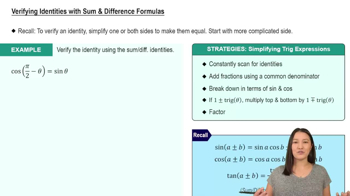Here are the essential concepts you must grasp in order to answer the question correctly.
Cosine and Sine Functions
The cosine and sine functions are fundamental trigonometric functions that relate the angles of a triangle to the ratios of its sides. The cosine function, cos(θ), represents the ratio of the adjacent side to the hypotenuse, while the sine function, sin(θ), represents the ratio of the opposite side to the hypotenuse. Understanding these functions is crucial for solving trigonometric expressions and equations.
Recommended video:
Graph of Sine and Cosine Function
Angle Difference Formula
The angle difference formula for cosine states that cos(α - β) = cos(α)cos(β) + sin(α)sin(β). This formula allows us to express the cosine of the difference between two angles in terms of the cosines and sines of the individual angles. It is essential for simplifying expressions involving the cosine of angle differences and is widely used in trigonometric calculations.
Recommended video:
Verifying Identities with Sum and Difference Formulas
Exact Values of Trigonometric Functions
Exact values of trigonometric functions refer to the specific values of sine, cosine, and tangent for commonly used angles, such as 0, π/6, π/4, π/3, and π/2. These values can be derived from the unit circle or special triangles. Knowing these exact values is important for evaluating trigonometric expressions without the use of a calculator, especially in problems involving angle addition or subtraction.
Recommended video:
Introduction to Trigonometric Functions






